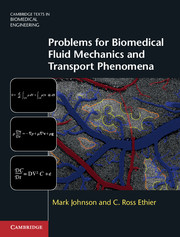Book contents
- Frontmatter
- Dedication
- Contents
- Preface
- 1 Problem solving
- 2 Conservation of mass and theReynolds transport theorem
- 3 Steady and unsteadyBernoulli equation and momentum conservation
- 4 Viscous flow
- 5 Momentum boundary layers
- 6 Piping systems, frictionfactors, and drag coefficients
- 7 Problems involving surface tension
- 8 Non-Newtonian blood flow
- 9 Dimensional analysis
- 10 Statistical mechanics
- 11 Steady diffusion and conduction
- 12 Unsteady diffusion and conduction
- 13 Convection of mass and heat
- 14 Concentration and thermal boundarylayers
- 15 Mass and heat transfer coefficients
- 16 Osmotic pressure
- Appendix A Material properties of fluids
- Appendix B Transport equations
- Appendix C Charts
- References
- Permissions
15 - Mass and heat transfer coefficients
(11 mass-transfer problems; 3 heat-transfer problems)
Published online by Cambridge University Press: 18 December 2013
- Frontmatter
- Dedication
- Contents
- Preface
- 1 Problem solving
- 2 Conservation of mass and theReynolds transport theorem
- 3 Steady and unsteadyBernoulli equation and momentum conservation
- 4 Viscous flow
- 5 Momentum boundary layers
- 6 Piping systems, frictionfactors, and drag coefficients
- 7 Problems involving surface tension
- 8 Non-Newtonian blood flow
- 9 Dimensional analysis
- 10 Statistical mechanics
- 11 Steady diffusion and conduction
- 12 Unsteady diffusion and conduction
- 13 Convection of mass and heat
- 14 Concentration and thermal boundarylayers
- 15 Mass and heat transfer coefficients
- 16 Osmotic pressure
- Appendix A Material properties of fluids
- Appendix B Transport equations
- Appendix C Charts
- References
- Permissions
Summary
In a blood oxygenator, the blood spends approximately 2 s passing through the device. Estimate a minimum value for hm, the mass transfer coefficient characterizing oxygen transport from the plasma to the inside of a red blood cell (RBC), such that the RBCs are completely (i.e. >99%) oxygenated before leaving the oxygenator (100% oxygenated refers to the maximum oxygen loading the cells can achieve in this oxygenator if the RBCs were left in the oxygenator for a very long time). You may assume that the RBCs entering the device are 50% oxygenated. Let the volume of each RBC be 98 µm3 and its surface area be 130 µm2. The diffusion coefficient of oxygen both in plasma and inside of the cell can be taken as 2 × 10−5 cm2/s.
A porous block attached to an air line emits tiny air bubbles (of diameter 0.15 mm, 21% oxygen) at the bottom of a fish tank filled with water at 25 °C. The absolute pressure in the bubbles at the bottom of the tank is 1.07 × 106 g/cm per s2 when they are released. They reach their terminal upward velocity almost instantly, since they enter the tank at nearly this velocity. Find the rate of oxygen transfer from one of these bubbles to the water. You may neglect the concentration of oxygen already in the water. The diffusion coefficient of oxygen in water is 2 × 10−5 cm2/s.
- Type
- Chapter
- Information
- Problems for Biomedical Fluid Mechanics and Transport Phenomena , pp. 142 - 150Publisher: Cambridge University PressPrint publication year: 2013



